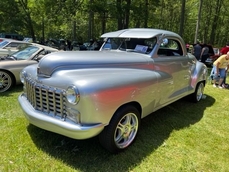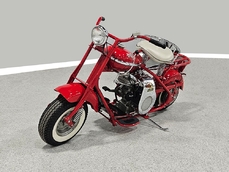Dodge Coupe 212 cubic inch inline-4 1927
General description :
The low-price field was pretty crowded in the 1920s, with Ford’s Model T remaining the sales leader year after year. But if you wanted an affordable car with a bit more substance than the rudimentary T, then the Dodge Brothers were only too happy to oblige. The Dodges’ cars were bigger, more comfortable, faster, and offered more contemporary styling for not a lot more money. In 1927, the final year of Model T production, Dodge Brothers factories rolled out three separate models, including the Series 128, which was an evolution of their “Fast Four” models. Were they fast? Well, they were certainly faster than the Model T, and with proven reliability, surprisingly good quality, and great road manners on their side, the Dodges offered a whole lot of car for the money. And fortunately for you, that remains true even today.
Look at this handsome 1927 Dodge Series 128 business coupe and then look again at the price—all out of proportion, don’t you think? Far more substantial than even a Model A, which would come the following year, this big, handsome coupe doesn’t look at all like it was built down to a price. Following a fairly high-quality restoration a few years ago, it has an elegant look and broad shoulders that suggest durability and style. Refinished in correct Gendarme Blue with black fenders, it looks period appropriate, a look that’s reinforced by details like the wood-spoke wheels, windshield visor, and upright grille. There’s a nice shine to the paint, which is probably better than anything they could deliver in 1927, and for a wood-framed vehicle it fits together remarkably well. The doors swing closed easily and make a great kerCHUNK sound and the coupe body style is ideal for touring. For ease of maintenance, the bright trim is now chrome instead of nickel and experts will spot the 1928 Model A taillight, but those are small deviations from stock and this isn’t intended to be a show car. You will also note aftermarket turn signals have been neatly installed on the front bumper and inside the rear spare tire bracket, adding safety on the road.
The interior is upholstered in black leatherette, which is not quite how this car would have been delivered new, but it’s a durable, low-maintenance choice for a car that’s going to be driven. Simple door panels were created to match, including map pockets, and there’s a lovely wool headliner overhead. Where Fords come with rubber mats, this Dodge carries carpets to add an upscale feel and help control noise and heat, although they are protected by a large rubber mat. The big wooden steering wheel looks fantastic and makes it surprisingly easy to wheel this Dodge around town, where its quick steering and torquey engine make it fun to drive. Factory gauges cover the basics of speed, oil pressure, and generator output, and someone has added an hour meter to the left of the steering wheel along with the toggle switch for the turn signals. The car has been converted to a 12-volt electrical system (earlier Dodges were 12 volts from the factory) so the headlight switches on the steering wheel hub are disabled, replaced by a subtle period-looking switch on the side of the column. Everything works correctly except the speedometer, but we have not investigated why—likely a cable. The shift pattern is standard 3-speed manual with light clutch action, but since synchros were still a few years away, it requires a quick double-clutch between gears. This is strictly a 2-passenger vehicle, as the business coupe offers a large trunk in place of a rumble seat, and that’s why this is a great tour car: lots of space for gear.
Dodge’s 212 cubic inch inline-4 evolved quickly in the mid-20s, and it was rated at 44 horsepower when this car was built (that’s more than twice the output of the Model T and even more than the upcoming Model A). This one appears to have been rebuilt during the restoration and runs superbly, starting easily with 12 volts running through the starter and ignition system and getting fuel using an electric fuel pump instead of a vacuum tank (which is still in place to keep the engine bay looking correct). The original carburetor is a beautiful little piece of ‘20s technology with a miniature flame arrestor and neatly designed manifolds. You will note that the original generator is gone, replaced by a custom jack shaft that still powers the original water pump, and a modern 12-volt alternator was mounted on the driver’s side. That 12-volt alternator also allows the use of a big electric fan on the radiator, so this Dodge runs cool and is almost immune to warm weather issues and as I mentioned the starter spins it over with vigor. We’re usually purists, but we can’t argue with how well this handsome Dodge works. It start easily, idles nicely, and runs down the road quite well.
The chassis is standard mid-20s hardware: rigid axles on leaf springs, rear drum brakes, and a rear axle big enough to use under a semi tractor. The Dodge rides notably better than a Model T or Model A and don’t be afraid of the rear-only brakes, as they’re quite effective for the car’s weight and performance. The 3-speed manual transmission shifts easily and you’ll get the hang of it quickly and easily with a little practice, and the 3.76 gears in back mean it’s pretty comfortable at 45-50 MPH so it’s never a rolling roadblock in today’s traffic. It’s nicely finished with plenty of evidence of the frame-off restoration and there’s no evidence of rust or rot or botched repairs underneath. A new exhaust system gives it a nice 4-cylinder grumble that quiets down at speed and we really can’t complain about any of this car’s behavior on the road—it just works! Handsome wood-spoke wheels were surely refinished during the restoration and now wear flashy new 4.75/5.00-19 whitewall tires.
Extras include a factory mechanic’s instruction manual, hub wrench and crank, plus some spare parts.
This is a great entry-level hobby car for the guy who wants a taste of the ‘20s. More robust than most of the other cars in its price class (and cheaper than a comparable Model A Ford), it’s the kind of car that stands out in a crowd no matter who’s there. Add in the great road manners, durable hardware, and strong parts and club support, and you get a car that is easy to love and makes sense for first-timers and experienced hobbyists alike. And if you’re a Mopar fan, this is where it all started. Call today!
Harwood Motors always recommends and welcomes personal or professional inspections of any vehicle in our inventory prior to purchase.
http://www.harwoodmotors.com/vehicles/inventory_details.php?id=1283
1927 Dodge Coupe 212 cubic inch inline-4 is listed sold on ClassicDigest in Macedonia by for $17900.
Car Facts
Car type : Car Make : Dodge Model : Coupe Model Version : 212 cubic inch inline-4 Engine size : 0.0 Model Year : 1927 Sub type : Coupé Location : Ohio
Sold
Seller Information
Sold
People who viewed this Dodge Coupe also viewed similar Dodge listed at ClassicDigest
Other cars listed for sale by this dealer
About Dodge
Dodge Brothers Company, founded by Horace and John Dodge in 1900, initially produced components for car manufacturers. In 1914 they stepped into car manufacturing when introducing four-cylinder Dodge Model 30 with all-steel body and 12v electric system.By 1920 Dodge had become the second biggest car manufacturer in the USA, unfortunately the same year both of the brothers died, the company in turn to was sold to Chrysler Corporation in 1928. Dodge found a niche Chrysler Corporation lineup above low-priced Plymouth and medium-priced DeSoto, but somewhat below the top-of-the-line Chrysler























